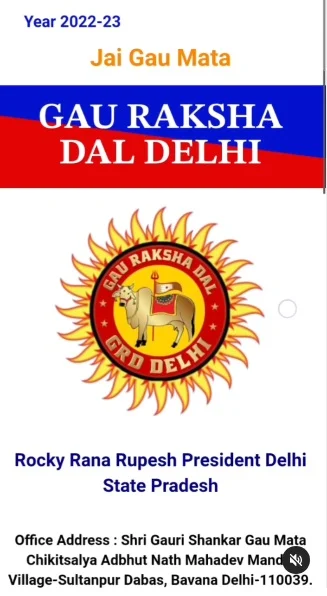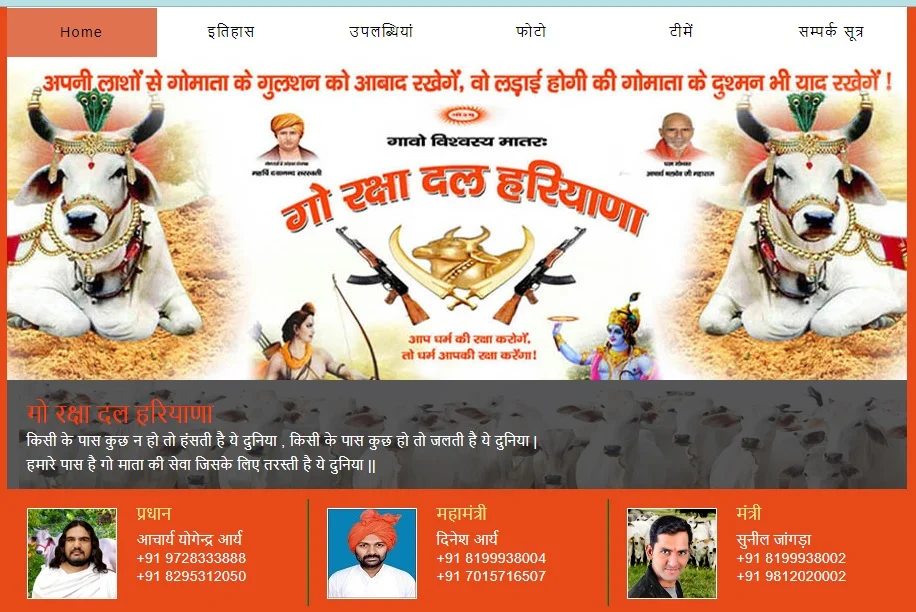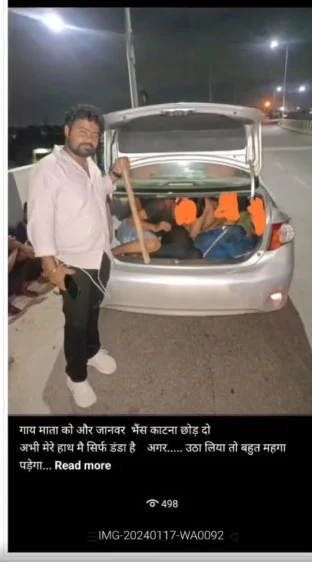NEW DELHI: A surge in cow vigilante violence primarily targeting Muslims in India’s capital and neighbouring states has raised concerns among media and activists about the unchecked rise of extremist groups posing as Gau Raksha Dals, in the name of protecting cattle.
Surge in Cow Vigilantism in Modi’s Third Term
Civil rights organizations and opposition leaders have raised alarms over a disturbing trend of violence linked to cow vigilante groups in India. Reports indicate that at least 55 individuals have died in approximately 50 incidents involving these groups during Prime Minister Narendra Modi’s first two terms. As a 2019 report by Human Rights Watch documented at least 44 deaths between 2015 and 2018 at the hands of cow protection groups. With more than a dozen attacks documented in just the first 100 days of his third term, concerns are escalating.
“There have been waves of cow vigilantism throughout all three terms of Modi’s government, but the initial months of Modi 3.0 have seen a particularly sharp resurgence of such violence,” stated Muhammad Akram, a policy researcher who has studied the issue extensively.
Indiatomorrow.net reports that the trend of discriminatory legislation and communal violence has intensified during Modi’s third term, with a notable rise in cow vigilantism and armed vigilante groups, especially in election-bound states like Maharashtra and Haryana. These groups have engaged in violent attacks against Muslims, often lynching individuals on mere suspicion of carrying beef or transporting cows for slaughter. Some armed gangs patrol highways at night, particularly active in Delhi and neighbouring states like Haryana and Rajasthan, claiming to protect cattle. Reports indicate that these vigilantes can be bribed to allow safe passage for cattle transporters. Analysts suggest these groups operate with political backing from the ruling BJP, specifically targeting Muslims involved in the cattle trade.
Disturbing Pattern of Violence and Gau Rakshak Dals
In the Delhi National Capital Region (NCR) and nearby states like Haryana, Rajasthan, and Uttar Pradesh, a disturbing pattern of violence by cow vigilante groups has emerged. Recent media reports have exposed these groups, which operate under the guise of ‘Gau Rakshak Dals.’ These armed gangs are engaging in extremism and violence in their regions, and now the national capital is not exempt from their aggressions. According to an HT report, on August 8, a group of self-proclaimed cow vigilantes in Sonia Vihar, Delhi, apprehended three Muslim men transporting meat, claiming it was cow meat. They allegedly tortured the three young men—identified as Ayyub Hussain, Mohd Mursaleem, and Mohd Meerajul—who were later arrested by police and charged under the Prevention of Cruelty to Animals Act, while the vigilantes faced no charges. A video of the incident, posted on social media by the “Gau Raksha Dal Delhi” on August 29, showed the men tied up, with the group’s leader, Rupesh Rana (known as Rocky Rana), seen assaulting one of them even in front of the police. Authorities described the situation as sensitive, claiming the men were tied up for possessing a cleaver.

Despite numerous instances of violence captured on video—including one incident where Rana was seen assaulting men while they were held in the back of a car as police patrols passed by—authorities have yet to take action against him or his group. This incident is not isolated. Recent months have seen a troubling rise in lynchings and murders by cow vigilantes, with a growing list of tragic incidents. Despite clear evidence of unlawful detention and assault, local authorities have yet to take action against the perpetrators, raising questions about the impunity enjoyed by such groups.
On September 15, a fact-finding team from JNU Students’ Union, AISA, and CPIML visited Hansawas Khurd, Haryana, where they found an atmosphere of fear following the lynching of 24-year-old Sabeer Mallik. All migrant Muslim families have reportedly fled the area since the incident. Mallik was killed on August 27 by far-right vigilantes who accused him of carrying beef. His murder has drawn attention to the extreme violence and intolerance fostered by these self-styled “cow protectors,” operating with impunity. After visiting the victim’s family, JNU Student Union President Dhananjay called for a nationwide ban on such vigilante groups.
In February 2023, the charred remains of Nasir and Junaid, two Muslim men from Rajasthan, were discovered in a burnt SUV in Haryana. Their families have accused prominent cow vigilante groups of involvement, including members of the Bajrang Dal, a right-wing Hindu organization.
The violence perpetrated by cow vigilantes took a dramatic turn when Aryan Mishra, a Class XII student, was mistakenly identified as a Muslim cattle smuggler and shot dead by cow vigilantes in Haryana on August 23. The accused, who followed Mishra’s car for 30 kilometers, claimed they believed he was a Muslim. During a jail visit, the prime suspect, Anil Kaushik, who runs a similar cow vigilante group called ‘Live For Nation’ based in Faridabad, expressed remorse, saying he thought Mishra was Muslim before realizing he was a Brahmin.
In a related development, Bittu Bajrangi, a self-proclaimed cow vigilante involved in the July 2023 Nuh violence, has filed to run as an independent candidate in the upcoming Haryana assembly elections. Bajrangi leads the Gau Raksha Bajrang Force and is currently out on bail following the Nuh incident.
Another such group, Gau Rakshak Dal Haryana, headed by influential leaders, faces accusations of violence and extremism, including forcing alleged smugglers to consume cow dung. The group’s official website declares, “…Why shouldn’t our swords cut the hands of sinners for cow protection like Veer Shivaji? Why don’t our eyes bleed for cow killers?” It calls on its followers, “O cow-worshippers, don’t rely on the government and rulers. Rulers are selfish; they understand only the language of power. If we show our power by getting organized, then even power will come under our feet. If we have to save the nation and our culture, then we will have to follow the commands of the Vedas. The Vedas say that if any wicked person kills a cow, then shoot him with bullets.”

According to a Guardian report, Yogendra Arya, head of Gau Rakshak Dal Haryana, one of the largest groups, agreed to take the Guardian on patrol with his men, granting rare access to the world of Hindu extremists, where holy men wield weapons, and youths risk death nightly to protect “mother cow.” “When we travel at night, we keep weapons. We also shoot and have killed some smugglers, and the smugglers also fire at us. We have lost five of our volunteers,” Arya told the Guardian.
The group’s deputy head, Acharya Azad Singh Arya, a prominent figure in Haryana’s cow vigilante movement, has gained notoriety following the alleged murders of Junaid and Nasir in February 2023. As a leader within the Bajrang Dal, Azad has been vocal in supporting violent cow protection efforts, calling for harsh measures against cow smugglers and praising vigilantes like Monu Manesar. He often appears with armed supporters, emphasizing a militant approach to cow protection. In a recent interview, he justified violent reprisals against suspected cow smugglers, framing such actions as necessary for the preservation of cow welfare. The police have implicated Azad in protecting those accused in the Junaid and Nasir case, highlighting his connections to various violent incidents involving cow vigilantes. His relationship with other vigilante figures, particularly arrested Monu Manesar, underscores a broader network promoting aggressive cow vigilante doctrines in Haryana.
The Rise of Digital Cow Vigilantism and Violence
The role of social media in amplifying cow vigilantism cannot be overstated. Platforms like Facebook, Instagram, and YouTube have become breeding grounds for extremist doctrine, allowing vigilante groups to gain followers and spread their message with alarming efficiency. Lawyer and investigative journalist Ashish Khetan’s recent article, “India’s Alarming Failure to Rein in Cow Vigilantes and the Role of Social Media,” published by the Center for the Study of Organized Hate (CSOH), a Washington-based think tank, explores several incidents in which cow vigilante groups posted videos and photos on social media for glorification, garnering support and recruitment. Khetan writes, “The tragic killing of Aryan Mishra, a high school student in India’s Haryana state, allegedly shot by a notorious cow vigilante named Anil Kaushik, casts a searching spotlight on the deep-rooted failures of Indian law enforcement and the unimpeded rise of cow vigilantism.”
Cow vigilante groups like those led by Anil Kaushik, Rocky Rana, and Monu Manesar have leveraged social media to glorify their illegal activities, instill fear in minority communities, and gain legitimacy.
Kaushik, with a significant following of over 10,000 on Facebook and nearly 25,000 YouTube subscribers, showcased dramatic car chases and confrontations, building a substantial digital empire that drew public sympathy and support.
Manesar, known for his violent methods, similarly utilized social media to amplify his influence, boasting over 200,000 YouTube subscribers. His live streams of high-speed chases further fueled a culture of intimidation, culminating in serious legal consequences, including his recent arrest in connection with violent incidents.
Similarly, Rupesh Rana, leader of the Delhi-based Gau Raksha Dal, boasts a following of over 93,000 on Facebook and 21,000 on Instagram, frequently posting videos showing him allegedly assaulting individuals accused of cow smuggling.
Experts highlight that these broadcasts not only intimidate minorities but also inspire copycat actions among other vigilante groups. The systemic failure of law enforcement to address the rampant activities of these groups reflects a broader societal collapse. As journalist Khetan noted, “The impunity with which cow vigilantes operate is indicative of a broader systemic collapse,” exacerbated by the role of social media in spreading hate and violence.
Public Outcry and Reactions
Reactions from various political leaders, activists, and commentators have intensified, highlighting growing concerns over cow vigilantism in India.
Meenakshi Ganguly, deputy Asia director of Human Rights Watch, emphasized the troubling nature of these incidents, noting, “We are seeing concerning new cases of abuses over unfounded claims of beef consumption or cattle slaughter.”
Prashant Bhushan, a prominent lawyer, criticized the state’s failure to protect minorities, stating, “Just like bulldozers being used to demolish houses of minorities, cow vigilantes are another group promoted by BJP governments to kill and lynch people, particularly minorities on the streets.”
Saket Gokhale, a Member of Parliament from the Trinamool Congress, lambasted the situation in the nation’s capital, remarking, “While Modi posts reels of himself with a calf, this is the pathetic and appalling condition in the so-called ‘VIP’ area of India’s capital.” He emphasized the ongoing violence against Muslims across India, questioning the effectiveness of local governance in preventing such incidents.
Karthik Srinivasan, a communications strategist, termed the situation “cow vigilante terrorism” encroaching into the capital, while Gargi Rawat, an NDTV news anchor, highlighted the disturbing inaction of the police during these incidents, pointing to a recent case where officers did little to intervene as a vigilante physically assaulted a captive.
Kenneth Roth, former executive director of Human Rights Watch, noted that cow vigilante violence has surged under the Modi administration, suggesting a link between these groups and political patronage from the ruling BJP, who often target Muslims suspected of cattle trading.
Gaurav Sabnis, an associate professor, pushed for a change in terminology, stating, “Calling these people ‘cow vigilantes’ is like calling Jeffrey Epstein a fertility vigilante. Let’s please get rid of that phrase and refer to terrorists as terrorists.”
Mohammed Zubair, founder of ALTnews, lamented the normalization of hate crimes in India, expressing frustration over the media’s lack of coverage and the ongoing justification of such violence. He pointed out the case of Rocky Rana, a known cow vigilante in Delhi, who openly shares violent videos of attacks and incites further violence without fear of repercussions from law enforcement.
In 2018, the Supreme Court of India issued a set of guidelines aimed at preventing cow vigilantism, including the appointment of nodal police officers in each district and prompt action against vigilantes. However, the implementation of these guidelines has been inconsistent across states. Even, some political parties have been accused of tacitly supporting cow vigilante groups to consolidate their Hindu voter base. The issue of cow vigilantism has also drawn international attention, with human rights organizations expressing concern over the targeting of minority communities. The U.S. State Department’s annual report on international religious freedom has also highlighted the rise in cow vigilantism as a concern for religious minorities in India.

